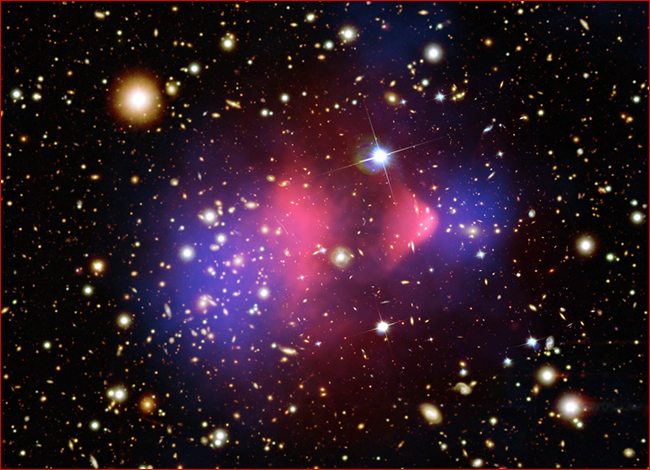
home •
about •
essential guide •
picture of the day •
thunderblogs •
news •
multimedia •
predictions •
products •
get involved •
contact
picture of the day archive subject index
Optical image from Magellan and Hubble Space Telescope shows galaxies of the “Bullet Cluster” 1E0657-56 in orange and white. X-ray image from Chandra shows x-ray emission in pink.
Credit: X-ray: NASA/CXC/CfA/M.Markevitch et al.; Optical: NASA/STScI; Magellan/U.Arizona/D.Clowe et al.
Sep 04, 2006
Bullet Cluster Shoots Down Big Bang
Optical and x-ray images of the galaxy cluster named 1E0657-56 have provided direct proof that these clumps of disturbed galaxies are small, faint, and nearby. These and many similar observations directly contradict the foundational assumptions of the Big Bang, which place the objects far away.
What we have stated in the headline and abstract above is, of course, an interpretation, not a fact. But the distinction between interpretation and fact has become so muddled in the sciences that we felt obliged to underscore the point rhetorically. Unbending theoretical assumptions have wrought havoc on popular astronomy, which could not recognize our interpretation of the Bullet Cluster based on the known electrical behavior of plasma.
According to the authors of the Chandra X-Ray Observatory website, the galactic cluster imaged above "was formed after the collision of two large clusters of galaxies, the most energetic event known in the universe since the Big Bang." Though the announcement by the Chandra team never uses the words "theory," "hypothesis," or "interpretation," its every sentence rests on a jumble of assumptions, from supposed galactic "collisions" to wildly conjectural "gravitational lensing," all wrapped around the discredited notion that redshift is a reliable measure of velocity and distance. The capper is the announcement appearing in numerous scientific media that the image "proves the existence of dark matter."
In electrical terms, the Hubble optical image shows the many distorted galaxies and filaments of plasma that have been identified by the astronomer Halton Arp as the fragments of a quasar (QSO, or quasi-stellar object) after it has moved through an evolving, highly redshifted and unstable "BL Lac" phase. The BL Lac transition breaks up the increasingly massive plasma of the quasar as it progresses toward becoming a companion galaxy.
From an electrical vantage point, the Chandra x-ray image (pink) clearly shows the bell-shaped terminus and following arc of a plasma discharge “jet.” . The strong magnetic field of the current causes electrons to emit the x-ray synchrotron (non-thermal) radiation captured in the image. Synchrotron radiation is a normal electrical discharge effect.
But popular astronomy, oblivious to electrical phenomena, sees only "hot gases colliding."
The cluster has a redshift of z=0.3, exactly the value of the Karlsson quantization peak that is typical of BL Lac objects. Because it therefore does not need to be normalized to the base redshift of another galactic group, it is likely a member of our Local Group. This is confirmed by its location in the ejection cone of M31 (Andromeda Galaxy), which includes M33, 3C120, many QSOs, and hydrogen plasma cells strung between M31 and the Milky Way. Because of its proximity to the Milky Way and the Large Magellanic Cloud, its precursor QSO was probably ejected from one or the other. Statistically, as astronomer Halton Arp has pointed out again and again, galaxy clusters occur preferentially near large, low-redshift galaxies.
The filaments, arcs, and clumps of higher-redshift plasma that group around many of the galaxies in the cluster indicate regions of secondary plasma pinching and ejection. Further examination is expected to reveal the typical pattern of decreasing redshift and increasing luminosity with increasing distance from the secondary concentrations.
The Big Bang, which fails to take the electrical properties of plasma into account, assumes that redshift must be an indicator of distance. As a result, it projects the high-redshift filaments and arcs far into the background. In order to account for the association of these features with foreground galaxies, gravitational lensing must be invoked to “explain away” the number of features as multiple images of only one “distant” QSO. But even this subterfuge is in vain: The number of the allegedly distant objects should, on the astronomers' assumptions, increase with faintness, but observed numbers actually decrease.
"Gravitational lensing" requires enormous amounts of mass. But among galaxies whose distances have been ascertained by methods other than the redshift assumption, “grand design” spirals and ellipticals are the most massive. Distorted and peculiar galaxies, which make up the bulk of clusters like 1E0657-56, are dwarf low-mass objects. Big Bang theorists simply ignore the evidence of the images, calculate the mass required to produce the desired amount of lensing, and announce that it exists as “dark matter” that can’t be seen.
___________________________________________________________________________Please visit our Forum
The Electric Sky and The Electric Universe available now!

|
|

|
EXECUTIVE EDITORS:
David Talbott, Wallace Thornhill
MANAGING EDITORS:
Steve Smith, Mel Acheson
CONTRIBUTING EDITORS: Dwardu Cardona, Ev Cochrane,
C.J. Ransom, Don Scott, Rens van der Sluijs, Ian Tresman
WEBMASTER: Brian Talbott
Copyright 2006: thunderbolts.info
![]()
home •
thunderblogs •
forum •
picture of the day •
resources •
team •
updates •
contact us

